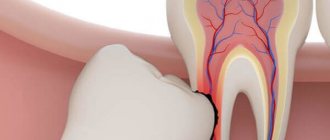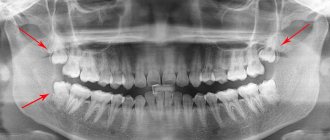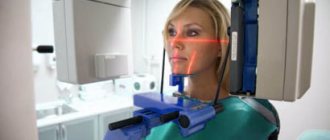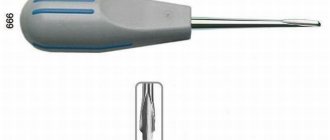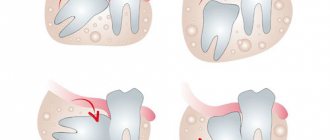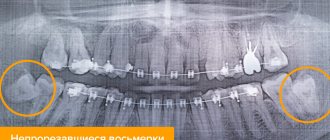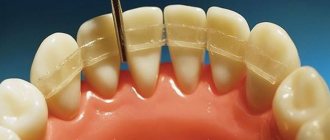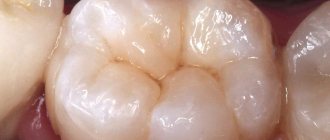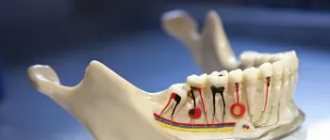Removal of the upper wisdom tooth under the guidance of surgeons with 25 years of experience, in conditions of increased comfort and at competitive prices.
One of the most labor-intensive procedures in dentistry is the removal of the figure eight in the upper jaw. Due to its abnormal location, the presence of roots with tortuous bends, as well as in the case of partial eruption of wisdom teeth and the proximity of the maxillary cavities, extraction becomes the only way out of the situation. In this case, it is better to deal with qualified specialists and contact trusted clinics.
In our dentistry you will be met by professional surgeons who know modern methods of removing problem teeth, use advanced instruments and effective anesthetics in their work. All this guarantees a shortened procedure time and the absence of any discomfort during it.
From this article you will learn in detail about all the nuances associated with the removal of a wisdom tooth in the upper jaw.
Free consultation
Our specialists will conduct a free consultation and select the best treatment option for you.
Sign up now! Online registration
+7 (495) 649-41-19
Content
1 Is it easier to remove a wisdom tooth in the lower or upper jaw?
2 In what situations is it necessary to remove a wisdom tooth in the upper jaw?
3 Anesthesia for removal of the upper wisdom tooth
4 Simple removal of wisdom teeth in the upper jaw
5 Difficult removal of the upper wisdom tooth
6 Removal of a completely destroyed upper wisdom tooth
7 Is it painful to remove a wisdom tooth in the upper jaw?
8 Consequences after removal of the upper wisdom tooth
9 Recommendations for recovery after removal of the upper wisdom tooth
10 Prices for wisdom tooth removal in the upper jaw
Is it easier to remove wisdom teeth in the lower or upper jaw?
Wisdom teeth are the last to appear on the jaw and have a complex structure, which greatly complicates treatment procedures. In addition, due to the presence of widely spaced and curved roots, the process of extracting the “eights” is significantly more complicated. However, there are significant differences between the removal of such teeth in the upper and lower jaw.
Molars located in the lower jaw are more difficult to extract because they experience more pressure and have more tortuous and durable roots. As a result, when extracting “eights” in this section, the surgeon applies more force, which can cause injury to adjacent units or gums, as well as a jaw fracture. Moreover, lower eighth teeth have 1-2 more roots than their upper counterparts, which also complicates the extraction process.
As for the removal of the upper wisdom tooth, the situation here is somewhat different. The upper jaw is less dense and has a larger number of vessels and nerve endings. Moreover, when anesthetics are administered before removing a wisdom tooth in the upper jaw, any consequences in the future are excluded. In turn, anesthesia of the mandibular region is accompanied by loss of sensitivity of the tongue, face and throat.
Wisdom teeth - difference from other teeth
This tooth is no different from other molars in its structure. If it erupts without pain, does not cause discomfort to the person and has normal roots, then they do not get rid of it. Its cutting is often accompanied by acute or dull pain, lack of comfort when eating food and other unpleasant symptoms. The upper teeth can cause food stuck and damage to the mucous membrane, and the lower teeth can lead to the formation of a purulent hood, caries, etc.
The main differences are two factors:
- excessively curved or fused roots;
- the same curved root canals.
The first factor is reflected in the difficulty of extraction: the roots grow together and can have the most bizarre shapes. This is what causes the main difficulties for painless elimination. The second factor provokes difficulties with further treatment: canals of this shape are very difficult to subject to filling and mechanical stress.
In what situations is it necessary to remove a wisdom tooth in the upper jaw?
In some cases, it is possible to save the “eight”. For example, in the presence of carious lesions, inflammatory processes in the pulp area or periodontal tissue disease. If you contact a specialist in a timely manner, the necessary treatment measures are carried out, and the damaged tooth can be restored.
However, in advanced situations, treatment becomes impossible, and removal of the wisdom tooth in the upper jaw is the only solution to the problem. Moreover, such a need may appear already during the period of eruption of the “eight”, which is accompanied by the occurrence of severe pain, an increase in body temperature and the appearance of edema. In this case, the indication for surgical intervention is the atypical shape of the roots, their incorrect location and curvature of the tooth.
Next, we will describe the factors that require immediate removal of a wisdom tooth in the upper jaw. These include:
- If a recently erupted or impacted tooth has an abnormal location, which creates obstacles to the growth of neighboring units and injures the gum tissue;
- In the presence of massive carious lesions and significant damage to the crown;
- Trigeminal neuralgia, accompanied by burning, intense pain;
- Inflammatory process in the area of gingival tissue located in close proximity to the erupting tooth;
- Fixation of bracket systems in situations where the last “eight” in a row prevents changes in the position of neighboring units;
- The presence of cystic formations in the root area.
According to leading experts in the field of dentistry, it is necessary to monitor the condition of wisdom teeth at the initial stage of their development. For preventive purposes, an x-ray is taken. Based on the results of this examination, the doctor identifies existing pathologies and gives appropriate recommendations.
If a specialist diagnoses the fact of an abnormal position of the tooth, then, most likely, he will advise immediate extraction of the root system. Removal of unerupted upper wisdom teeth is performed with less effort. In this case, there is no likelihood of negative consequences, and the recovery period is much easier.
Indications for removal
If the extreme molars are formed correctly, then they are no different from other teeth. They can be affected by caries, which turns into pulpitis, periodontitis and other diseases. The dentist decides whether to remove a wisdom tooth after a detailed examination of the x-ray. It shows the location, quantity, structure of roots, carious cavities, condition of the canals, direction of growth, neoplasms and other pathologies.
The tooth is removed if there is:
- advanced form of caries with complications: pulpitis, cysts, complex, tangled canals that cannot be properly cleaned and sealed;
- neurological pain, constant inflammation of tissues during teething, partially erupted teeth (pericoronitis);
- strong pressure on neighboring molars, pathological changes in bite;
- incorrect position of the teeth, which leads to injury to the mucous membranes.
Carious lesions and inflammation on figure eights occur quite often due to the difficulty of access for hygiene procedures. If caries is not cured in a timely manner, it will spread to neighboring teeth, since they are located very close to each other.
During the growth of the last molars, branches of the trigeminal nerve tissue may become inflamed. In this case, not only the jaw hurts, but also the head. If the problem cannot be eliminated by therapy, then removal is performed.
When there is little space on the jaw, an overgrown wisdom tooth can put a lot of pressure on neighboring dental units, causing constant pain and changing the correct bite. For the same reason, they can grow crookedly, cut into the gums from the side and injure the mucous membranes of the cheeks.
The third molar takes a long time and painfully to erupt. Bacteria penetrate into the slightly open gum tubercle, food particles enter, causing an inflammatory process. The soft tissues become inflamed, causing pain that radiates to the ear and temple. Under the “hood” a favorable environment is created for the development of bacteria, so inflammation develops quickly and purulent contents appear. This position can lead to melting of bone tissue and other complications, so the dental unit is removed and anti-inflammatory therapy is carried out.
Often a cyst forms on wisdom teeth. The disease is asymptomatic and is detected only during instrumental examination of the jaw. If it is not removed, it can subsequently become a source of severe inflammation, osteomyelitis.
Anesthesia for removal of the upper wisdom tooth
As a rule, before extracting the “eight”, they resort to local painkillers - injections with articaine, lidocaine and other drugs with a similar spectrum of action. The dentist makes 2 injections - from the side of the palate and on the outside of the upper jaw. This allows you to obtain a powerful anesthetic effect, which manifests itself within 2-5 minutes after administration.
In the case of the eighth tooth, located in the mandibular region, at least 9-10 minutes are required due to the increased bone density in this area.
However, the pain syndrome can make itself felt within 2-3 hours after surgery, which requires additional use of painkillers and anti-inflammatory drugs.
Simple removal of wisdom teeth in the upper jaw
When performing the above procedure, the need to use a scalpel and dissect the gums is eliminated. Most often in this situation they resort to the help of a special surgical instrument - an elevator, or standard hand forceps.
Such removal of the upper wisdom tooth, as evidenced by reviews, is performed when there are no obstacles to removing the tooth from the socket:
- The root of the tooth is of medium length, without curvature;
- The “eight” protrudes onto the gums, which makes it possible to remove it with forceps;
- The tooth is single-rooted, or it has several roots fused into one.
To facilitate the extraction procedure, the specialist uses forceps with an S-shaped bend. If an upper wisdom tooth, significantly destroyed by caries, is removed, they resort to bayonet instruments, which are considered universal for carrying out this kind of manipulation. The latter have cheeks with a pointed shape, which have the ability to close and firmly hold the tooth roots.
Algorithm of surgical intervention:
- Applying the instrument to a figure eight crown.
- Immersion of the cheeks under the gum tissue covering the neck of the tooth.
- Advance the forceps to the desired depth and fix them on the tooth.
- Loosening of the unit in the buccal direction and its dislocation (luxation).
- Extraction of a wisdom tooth from the alveolar socket (traction).
To stop bleeding, the surgeon quickly applies a gauze pad to the sore area. As a rule, the duration of the procedure does not exceed 10 minutes.
Complex removal of an upper wisdom tooth
As part of this procedure, drills are used, and the gingival tissue is dissected and the dental socket is sutured. Swelling after such removal of the upper wisdom tooth is considered a normal manifestation. The reason for this operation is the eruption of the tooth in a horizontal position, under a layer of bone tissue.
Procedure steps:
- Initially, the site of future intervention is anesthetized.
- The gum is dissected and part of it is peeled off using a scalpel.
- A hole is created in the bone tissue. In this case, special tips and cutters are used to provide a cooling effect.
- Full or partial extraction is performed.
- The dental alveolus is thoroughly washed with an antiseptic solution.
- The bone wound undergoes plastic surgery, and the detached part of the gum is returned to its place.
- Suturing the alveolar cavity and stopping bleeding.
After implementing all the sequential steps and removing the upper wisdom tooth, the specialist makes recommendations regarding further care.
Recommendations after removal
When the doctor has removed a wisdom tooth, he leaves a special tampon in the socket so as not to provoke the development of any infection. The patient should remove it after 5-10 minutes. You should not touch the hole itself with your tongue, finger or foreign objects. If you feel as if something is stuck in the socket after removal, you should contact your dentist. The doctor could have deliberately left a stash of medicine there for quick healing.
Prohibited after removal:
- Drinking alcohol.
- Drink and eat, especially hot food.
- Rinse your mouth - only make baths.
- Take a hot bath, steam in a bathhouse or sauna.
- Open your mouth too wide if the dentist has stitched it.
- Warm your cheek or face, because... swelling after removal tends to intensify.
If the patient does not follow the dentist's advice and violates the recommendations, the risk of developing oral complications increases. To prevent this from happening, you should strictly follow the doctor's instructions.
Recommended:
- Apply cold compresses.
- Take antibiotic medications if prescribed by your doctor.
- Make baths of soda and medicinal herbs, which are prescribed by the dentist.
- If your temperature rises after wisdom tooth removal, you need to take an antipyretic.
- Pain after wisdom tooth removal is relieved by taking painkillers prescribed by the dentist.
- Stick to a simple diet in the first days, i.e. do not eat hot foods, alcohol, fine-grained, viscous foods.
Removal of a completely destroyed upper wisdom tooth
If a patient has a completely destroyed wisdom tooth, removal of the upper molar becomes inevitable, since it becomes painful for the person to chew food. Unfortunately, not every specialist can cope with such a situation. Sometimes the “eight” has to be removed in parts, which requires a significant investment of time and painstaking work of an experienced surgeon.
First of all, this is due to the difficulties that arise when trying to fix a tooth with forceps. In this case, it may be necessary to dissect the gum tissue. In particularly difficult situations, it may be necessary not only to crush hard tissue, but also to saw through the bone in order to free access to the root part of the tooth.
Such surgical intervention is best performed in patients no younger than 40 years of age, since it is during this period that the alveolus undergoes atrophy.
Treatment of caries and other wisdom tooth diseases
The third molar is an ordinary tooth, which means it can be treated. True, it will be difficult (treatment during sleep may even be indicated), and this is due to the structure of the “eights” and their inconvenient location in the oral cavity.
Problems can also arise if the wisdom tooth is affected by pulpitis or periodontitis. This requires filling the canals, and they are very tortuous in the third molars. If the canals have poor patency, the dentist will recommend removal of wisdom teeth, as this will be less risky, because unfilled canals will give the inflammatory process a “green light” and it will spread further, resulting in the formation of a cyst or fistula.
“Wise” teeth usually take longer to treat than usual: treatment lasts 2-3 months and requires several visits to the dentist.
Is it painful to remove a wisdom tooth in the upper jaw?
According to many dental visitors, they are afraid of pain during the extraction procedure of the upper eighth teeth. Fortunately, today powerful anesthetic drugs have been developed that can relieve pain.
As a rule, patients report discomfort after surgery. This is due to the cessation of the action of painkillers. To get rid of unwanted complications after removal of the upper wisdom tooth during the recovery period after surgery, the specialist additionally prescribes anti-inflammatory and anesthetic agents.
At the Elident clinic, experienced surgeons with 25 years of experience will work with you, who use modern instruments in their work, regularly carry out interventions related to the extraction of “eights” and use effective methods of anesthesia. This guarantees increased comfort during the procedure and eliminates complications after it. In addition, we provide important recommendations that must be followed after the removal of the upper wisdom tooth in order to avoid unwanted manifestations in the future.
How long will an extracted tooth hurt?
Removing a wisdom tooth is a serious surgical procedure that severely injures the soft tissues of the periodontium. The fact is that third molars are large teeth, having from 2 to 5 roots. And after their removal, an open bleeding wound remains in the jawbone and gum, which will definitely hurt. And not a couple of hours, but several days.
The pain can be aching and cutting, radiating to the throat or ear. The patient may complain of painful swallowing and persistent headache. An increase in body temperature to 37.5 0C is also natural and physiological. There is no need to endure unpleasant sensations. After tooth extraction, the dentist will definitely recommend painkillers:
- paracetamol;
- ibuprofen;
- analgin;
- butadione;
- sedalgin.
All of them are available without a prescription, are not addictive and have minimal side effects. At the same time, they effectively relieve pain. Normally, the pain at the site of the extracted tooth subsides within 3-7 days. And the final healing of the hole occurs by the end of 2 - 3 weeks after tooth extraction. During this time, she needs to be protected from injury - brush her teeth carefully, eat food carefully.
The appearance of edema is also natural after the removal of the figure eight. As a rule, it forms during the first day after surgery and lasts for the next 2 to 3 days.
If over time the pain does not subside, but, on the contrary, intensifies, you should immediately consult a doctor. Alarm signals are a strong increase in temperature, an unpleasant odor from the hole, acute pain radiating to the temple or ear. These symptoms may indicate the development of inflammation. And without the intervention of a dentist, the purulent process will lead to an abscess and sepsis.
But even if healing goes according to plan, most patients will have to see their doctor again 7-10 days after surgery. This time to remove the stitches. This procedure cannot be called painful, although it is unpleasant. If the patient's pain threshold is too low, the dentist will numb the area of the gum with lidocaine gel or spray.
Our clinics
Clinic "Elident" on Varshavskaya
Varshavskoe highway, 75, bldg. 1, Moscow 117556
- Varshavskaya (500 m, closed until 2021)
- Nakhimovsky Prospekt (1,300 m)
Mon-Sat : 09:00-21:00; Sun : 09:00-19:00.
Online registration
+7 (495) 649-41-19
Elident Clinic in Annino
Varshavskoe highway, 154, building 1, Moscow 117405
- Annino (500 m)
- Academician Yangelya (700 m)
Mon-Sat : 09:00-21:00; Sun : 09:00-19:00.
Online registration
+7 (495) 649-41-19
Consequences after removal of the upper wisdom tooth
Often, after the removal of upper impacted wisdom teeth, serious consequences become apparent, including:
- Injury to the oral cavity or soft tissues, which is caused by improper placement of the “eight”;
- If the damage is severe, a fracture of the root or crown part is possible. This is accompanied by an uncharacteristic crunch;
- Dislocation of an adjacent unit. If excessive force is applied or an inexperienced specialist participates in the procedure, nearby teeth may be damaged;
- Breaking off a piece of a tooth root. This occurs due to the instruments gripping the tooth too deeply;
- Alveolitis. It appears when the necessary rules of care are ignored or in the presence of chronic inflammatory processes, or when parts of the tooth are not fully extracted from the socket;
- Damage to the lower part of the maxillary cavity. One of the most severe complications.
Individual oral hygiene after wisdom tooth removal.
- For 3 days, you should not rinse your mouth vigorously, as this can lead to sutures coming apart and bleeding;
- You should brush your teeth and tongue as usual twice a day, without touching the postoperative area with a toothbrush;
- After each meal, carefully rinse your mouth with a warm decoction of chamomile, sage, arnica or oak bark, which has a mild antiseptic and tannic effect. If you don’t have any decoctions on hand, you can use chamomile or regular black tea (a strong solution);
Recommendations for recovery after removal of the upper wisdom tooth
After extraction of the upper wisdom tooth, at least 1-2 days are required for the patient’s rehabilitation. In some cases, this period may be delayed. To avoid complications, you must adhere to the following recommendations:
- Use antibacterial therapy prescribed by a specialist, as well as drugs that relieve inflammation and pain;
- Refuse to visit the sauna, swimming pool and bathhouse - in order to eliminate the possibility of wound infection;
- In the first days after the intervention, it is recommended to use soft products;
- If possible, stop using tobacco products.
We employ specialists of the highest category, which eliminates the possibility of making any mistakes during the procedure and guarantees a shortened and easy recovery period.
Features and difficulties during removal
Extraction of the upper wisdom tooth is complicated by its specific anatomical features.
“Eights” erupt late, when the dentition is already formed. Therefore, very often they are incorrectly located, grow together with the roots of neighboring teeth, grow towards the cheek or even horizontally. Each of these factors complicates the extraction process placed on top of the 8th tooth. But if we compare wisdom tooth removal from above and below, then in the first case the surgical procedure is much simpler. In the upper dentition, the bone is less dense and massive, there are much fewer blood vessels in the soft tissues and the risks of damage to the trigeminal nerve are lower. Therefore, the operation to remove the G8 is easier and safer.
Prices for wisdom tooth removal in the upper jaw
| Service | Price, ₽. |
| Surgeon consultation | for free |
| Carpule anesthesia (Ultracaine, Septanest, Ubistezin, Alfacain, Mepivastezin) | 500 |
| Application anesthesia of the mucous membrane (Lidocaine) | 150 |
| Removal of a tooth of increased complexity (wisdom teeth 1.8 2.8) | 3300 |
| Removal of impacted dystopic wisdom tooth | 5500 |
| Removal of lower wisdom tooth | 3000 |
| Removal of the lower wisdom tooth (advanced) | 4000 |
| Pocket cut | 500 |
The cost of this service may be influenced by: the complexity of the problem and the rating of the chosen dentistry. For example, the cost of an x-ray examination can reach 300-500 rubles. With a simple removal of the upper wisdom tooth, the price can be equal to 3500-7000 rubles. In turn, if a complex procedure is planned, be prepared to pay at least 4,000-9,000 rubles.
The Elident clinic has fixed an acceptable cost for such services - 3300-5500 rubles (depending on the complexity of the case).
Article expert (author):
